After Tier 1’s introduction to Native culture and history, the next step on the learning path is to know more about culturally appropriate outreach practices. What’s the best way to introduce your Parent Center to Native parents in rural or reservation areas, as well as to those families living in urban areas? Are there specific cultural protocols that Parent Centers should know—what to do or say, what not to? Where might Parent Centers meet Native parents of children and youth with special needs? What organizations or federal programs can help? The resources in Tier 2 respond to these questions and provide specific suggestions.
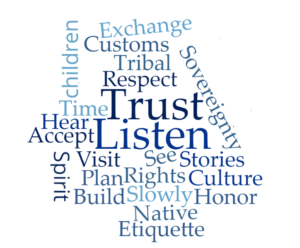 A library collection hosted by CPIR
A library collection hosted by CPIR
Developed by NAPTAC | Native American Parent Technical Assistance Center
Native Hawaiian resources were developed by LDAH | Leadership in Disabilities and Achievement of Hawaii
The materials in Tier 1 introduced and discussed the cultural and historical background that has impacted Native communities. Equipped with that awareness, the Tier 2 materials below will help you plan and conduct your outreach in culturally sensitive and appropriate ways. The materials address questions such as:
- How is creating a Native land acknowledgment an act of respect and outreach to local Native communities, past and present?
- How will our awareness of tribal sovereignty impact how we conduct outreach to American Indian and Alaska Native communities?
- What are our initial steps? What cultural awareness tips will help us? How do we introduce our Parent Center to various Native American communities?
- What opportunities for connecting with Native families exist? How and where might we connect with Native youth? Are there programs and points of contact that are particularly useful in schools?
- Are there specific cultural protocols to keep in mind when outreaching to Native Hawaiian parents?
- What resources will help my communication with Native Americans, such as with terminology and culturally appropriate images?
Several key cultural reference materials that were introduced in Tier 1 are repeated here in Tier 2 for those readers who began their research in Tiers 2, 3, or 4, and may have missed them.
Keeping Tribal Sovereignty in Mind During Outreach
Webinar | Tribal Sovereignty and Outreach to Native American Families
This 57-minute webinar led by Robin Butterfield is tailored expressly for Parent Centers to learn more about tribal sovereignty and its role and significance in history, in U.S. courts, and in current times. The webinar includes specific suggestions and activities that Parent Centers can use in staff development as part of internal capacity building and as part of outreach planning. Two worksheets are provided to guide Parent Centers in gaining specific knowledge of state or federal tribal communities in their area.
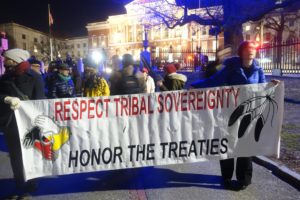 We are pleased to share the 2016 webinar with you, as well as the PowerPoint presentation (which includes speaker notes) and the two worksheets created for Parent Centers to use when researching tribes in their state or service area..
We are pleased to share the 2016 webinar with you, as well as the PowerPoint presentation (which includes speaker notes) and the two worksheets created for Parent Centers to use when researching tribes in their state or service area..
PowerPoint Presentation and Outreach Worksheets
PowerPoint slideshow | PDF of the slideshow
2016 Worksheet 1 in Word (Identifying the Tribes in Our Region)| Worksheet 1 in PDF
2016 Worksheet 2 in Word (Developing Your Own Tribal Directory) | The Worksheet 2 in PDF
Now, for your viewing and listening pleasure, here’s where to view the webinar.
https://youtu.be/3k1Q_cDanfw
_________________________
Tribal Sovereignty and Outreach to Native Families
This brief is a companion to the webinar of the same name. It offers a summary of how important tribal sovereignty is to tribes and tribal members, and explores how Parent Centers might plan and conduct outreach to Native families in state or federally reservations, who reside within the reality of tribal sovereignty and the governing policies of individual tribal communities. [4-page brief in Word and PDF, 2024]
Tribal Sovereignty and Outreach to Native Families in Word
Tribal Sovereignty and Outreach to Native Families in PDF
_________________________
 Native Land Acknowledgment: The Why and How for Parent Centers
Native Land Acknowledgment: The Why and How for Parent Centers
In recent years, across academic conferences, cultural gatherings, and social events, it has become commonplace for speakers to open by paying respect to the Native American communities—past and present—on whose original lands the event is taking place. Such statements are known today as Native land acknowledgments. By creating a Native land acknowledgment, your Parent Center recognizes displaced or disappeared peoples and tribes, while simultaneously acknowledging contemporary local Native communities. It’s a concrete way to show awareness of and respect for often-overlooked and underserved Native parent groups. It’s also a practice that’s deeply meaningful to Native communities, whose family members will respect you in return. Tips for creating your own Native land acknowledgment and samples are included. [4-page brief online, in Word, and PDF, 2024]
Native Land Acknowledgement for Parent Centers online in HTML
Native Land Acknowledgment for Parent Centers in Word
Native Land Acknowledgment for Parent Centers in PDF
___________________________________________
Initial Outreach Steps
We’re pleased to share two resources that you can use to inform your initial steps in conducting outreach to Native communities.
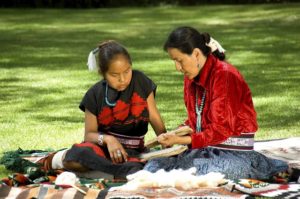 Cultural Awareness and Connecting with Native Communities
Cultural Awareness and Connecting with Native Communities
What are some cultural tips and protocols to know when reaching out to American Indian and Alaska Native communities? While etiquette will vary from community to community, there are commonalities as well. Observing them will enhance your Parent Center’s connectedness with Native families and communities. [4-page brief, available in Word and PDF, 2016]
Cultural Awareness and Connecting with Native Communities | in Word
Cultural Awareness and Connecting with Native Communities | in PDF format
___________________
Introducing Your Parent Center to American Indian Communities
Does your Parent Center cover a service region that includes one or more American Indian or Alaska Native communities? If so, this brief is written for you, especially if your Parent Center is gearing up for outreach to Native families or revitalizing prior connections with Indian communities. Included are suggestions for “first steps” in approaching and building relationships or strengthening partnerships with AI/AN communities. [3-page brief, available in Word and PDF, 2016]
Introducing Your Parent Center | in Word
Introducing Your Parent Center | in PDF format
Back to top
___________________________________________
Connecting with Native Families and Youth
Webinar | Working with Native Families: Barriers and Opportunities
This 58-minute webinar led by Dr. Marilyn J. Johnson is tailored expressly for Parent Centers and focuses on:
-
- How parent involvement impacts student achievement
- Early educational experiences of American Indian and Alaska Native parents
- Present-day educational experiences of AI/AN parents
- Benefits of family engagement in education
- Value of connecting with Native parents and overcoming historical barriers
We are pleased to share the 2016 webinar with you (linked below), as well as the PowerPoint presentation used in the webinar (which includes speaker notes).
PowerPoint Presentation and PDF
PowerPoint slideshow | PDF of the slideshow
Watch the webinar at:
https://www.youtube.com/watch?v=aXuzNK1AiUw&feature=youtu.be
_________________________
Webinar | Outreach to Native Parents via Title VI
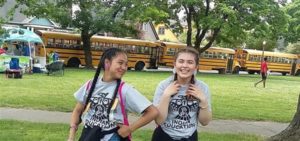 Title VI is known as the Indian Education Act, and has been part of the Every Student Succeeds Act (ESSA) since 1972. This 55-minute webinar led by Robin Butterfield explores the federally funded Title VI program, its roots and unique aspects, and how Parent Centers might include Title VI in their outreach initiatives to all Native American communities. We are pleased to share the PowerPoint presentation used in the webinar (which includes speaker notes), as well as a link to the 2017 webinar for your viewing pleasure. Immediately below, you’ll also find this webinar’s companion brief.
Title VI is known as the Indian Education Act, and has been part of the Every Student Succeeds Act (ESSA) since 1972. This 55-minute webinar led by Robin Butterfield explores the federally funded Title VI program, its roots and unique aspects, and how Parent Centers might include Title VI in their outreach initiatives to all Native American communities. We are pleased to share the PowerPoint presentation used in the webinar (which includes speaker notes), as well as a link to the 2017 webinar for your viewing pleasure. Immediately below, you’ll also find this webinar’s companion brief.
PowerPoint Presentation and PDF
PowerPoint slideshow | PDF of the slideshow
Watch the webinar at:
https://www.youtube.com/watch?v=D-tWEHGtD0c
_________________________
Outreach to Native Parents via Title VI
Title VI of the Every Student Succeeds Act (ESSA) targets federal funds to improve education of all Native American students in all grade levels and in all kinds of schools, particularly in public schools. The Act recognizes that American Indians, Alaska Natives, and Native Hawaiians have unique educational and culturally related academic needs and distinct language and cultural needs. This brief describes the work and activities of Title VI programs, including required Native parent committees that meet regularly, and suggests ways in which Parent Centers can utilize these educational programs to locate and outreach to Native American families in rural, reservation or urban school district. [4-page brief, available in Word and PDF, 2024]
Outreach to Native Parents via Title VI | in Word
Outreach to Native Parents via Title VI | in PDF
_________________________
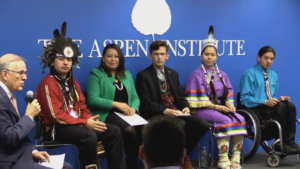 Reaching Out to American Indian and Alaska Native Youth with Disabilities
Reaching Out to American Indian and Alaska Native Youth with Disabilities
This expanded brief explores how Parent Centers might plan and conduct outreach to American Indian and Alaska Native youth with disabilities. By referencing Native-specific organizations and resources, this guide supports Parent Centers in addressing a key federal priority—that is, to connect directly with youth who have disabilities and to increase their capacity to be effective self-advocates. [8-page brief, available in Word and PDF, 2024. This guide is also listed under Tier 3 materials.]
Reaching Out to Native Youth | in Word
Reaching Out to Native Youth | in PDF
_________________________
State Indian Education Contacts
The list of State Indian Education Contacts was developed for Parent Centers and other service providers to use in identifying and connecting with the individuals who serve as their state contact for American Indian and Alaska Native education. These individuals can be very helpful to Parent Centers and others in establishing and building relationships within AI/AN communities in the state, and in learning about ongoing parent activities where Parent Centers could conduct outreach, especially after learning which schools in the state receive Title VI federal funds, indicating there’s a significant Native student population there, as well as required Native parent committees. Updated for 2019, the list of contacts is available in Word, PDF, and here online at CPIR, at:
https://www.parentcenterhub.org/state-indian-education-contacts/
_______________
Native American Images Collection
This curated collection of photographs and graphic images includes photos of Americans Indians, Alaska Natives, and Native Hawaiians, as well as images of Native American symbols. The resource was developed to assist Parent Center staff members and others who are conducting outreach to or maintaining working relationships with these three Native American communities. Native-themed photos and images from the collection can be added to organizational brochures describing services, flyers announcing upcoming workshops, training materials including handouts, and PowerPoint presentations. Culturally appropriate materials will improve outreach to and relationship-building with Native parents and communities. [Available and accessed through Smartsheet, 2024.]
https://app.smartsheet.com/b/publish?EQBCT=cfcf6286551e470dbbb3e0e1b82c7a97
Native American Terminology Guide
The intent of this booklet is to provide guidance to Parent Center staff, researchers and others interested in learning about and interacting with American Indians, Alaska Natives, and Native Hawaiians. The guide provides definitions of frequently used terms, including terminology used by the Federal Government in their relationship with tribes, villages and Native Hawaiians, as well as terms frequently used among Native community members. It can enhance cross-cultural communication, whether spoken or written. [52 page PDF guide, 2024]
Native American Terminology Guide
_______________
Which part of the Resource Collection would you like to visit now?
Return to the Native American Resource Collection’s landing page
Tier 1: Native Culture and Background
Tier 2: Outreach to Native Communities (You’re here now.)
Updated October 2024

